Drawing & Painting blog
REVIEW: THE BEST ARTIST’S PENCILS FOR SKETCHING & DRAWING
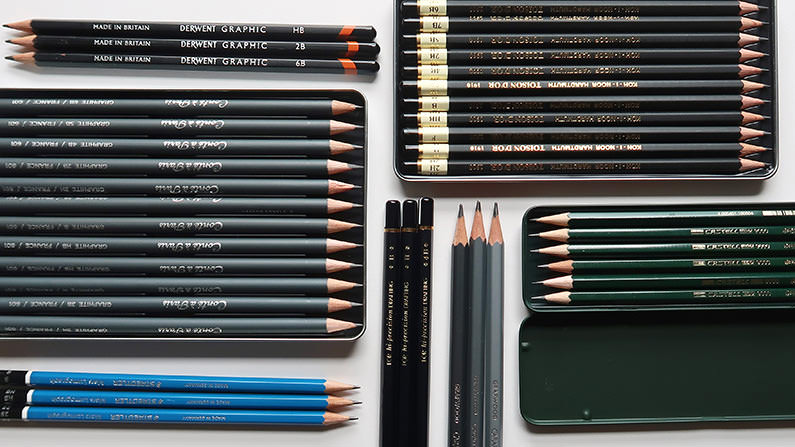
I’ve been drawing professionally for many years and have tried a very large number of premium quality pencil brands. There are no sponsored links in this review, however to give you an indication of each pencil’s price range I’ve included the cheapest UK price I could find at the time of writing (September 2020) as I like to support pencil retailers and especially those that import the less well known ranges.
The list of pencils I’m reviewing here is something of a snapshot of the UK market. I’ve had to exclude one of the most exalted pencils in the world – the Mitsubishi ‘Hi-Uni’ – because it’s almost impossible to source in the UK except through one importer who sells them at a cost of £3.40 per pencil. I’ll have to wait until I visit Japan!
Apart from this omission, I’ve included the professional ranges from all of the top pencil makers including Faber-Castell, Staedtler, Derwent, Koh-i-Noor, Tombow, Caran D’Ache, and Conté à Paris. I haven’t included of the cheap ‘student’ ranges and would urge you to buy artist’s grade pencils if you possibly can, because they will make a huge difference to your work and to your enjoyment of drawing.
What makes a good drawing pencil?
Here is what I’ll be looking for:
- It should be well ‘bonded’. Bonding means the way that the lead is glued to the casing (I’m going to continue to refer to the ‘lead’ here, although as we all know, pencil leads have always made of graphite) A poorly bonded pencil lead will break constantly especially when you sharpen it.
- The leads themselves shouldn’t break and snap off easily, for example when you press down on your paper or sharpen them with a craft knife.
- It shouldn’t shed a dust of tiny particles of graphite on your paper, an effect known as ‘ghosting’.
- The lead should be well mixed. Graphite pencils are mixed with a binder of clay, and different grades of softness and darkness are created by the varying the graphite and clay ratio. It’s vital that both graphite and clay should be finely ground and well mixed to give a uniform and consistent stroke. If they aren’t, you’ll encounter that gritty, ‘scratchy’ feeling (and sometimes even a squeaky noise) when you hit a lump of clay and your pencil doesn’t make a good mark.
Comparing the tones of different ranges
Before we begin the individual reviews, here’s a comparison of the grading values for all the brands I’m looking at. You can read more on the pencil grading system here, but to summarise briefly: pencils are graded on a scale that runs from the hardest grades which have a lot of clay in them and which make a very light mark, to the softest grades which have the least clay and mark very darkly.
The ‘HB’ grade is in the middle, the soft pencils are labelled ‘B’ for ‘black’ (B, 2B, 3B and so on) and the harder pencils begin with an ‘H’ for ‘hard’ (H, 2H, 3H etc). The ‘F’ grade is a bit of an anomaly, and is considered a ‘half’ grade between H and HB. In this comparison chart I’ve not compared grades softer than ‘H’, as one rarely uses these for fine art drawing.
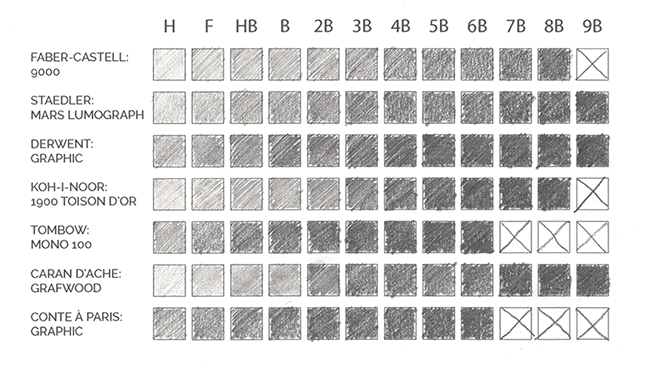
It is important to understand that there is NO industry standard for the darkness or lightness of any particular pencil grade. Companies apply the grading scale as they wish and as you can see there can be wild disparity between ranges, with a HB grade in a very dark range like Tombow’s ‘Mono’ pencil equating tonally to around a 5B in a very light range such as Faber-Castell’s ‘9000’ pencil.
It’s useful to know whether a range runs on the light or dark side, because most people will actively prefer one or other. For instance, grades 3H to 6H or higher would be usually considered more suitable for graphic or technical/industrial design than for sketching. However it should also be noted that because there is such variation in the way the scale is applied between different ranges, a 3H in a very soft dark range could function more like an HB from a much lighter range and could in fact be quite suitable for fine art drawing.
Whilst factors like strength and reliability are very important when judging pencils, people’s preferences will also be subjective in many ways. For example most people will probably prefer a pencil that doesn’t smudge very easily especially in the lighter grades, but if you actively want to smudge your pencils as part of your drawing technique then you’ll probably get on better with one of the softer brands, and may even seek out a range that gives off a lot of graphite dust. In many respects then the ‘best’ pencil for you will be very personal to the type of work you want to do.
FABER-CASTELL ‘9000’ PENCILS
★★★★★ My pick of the lighter ranges for perfect performance and reliability
RANGE 6H-8B, UK lowest price: £1.20 each (jacksonsart.com)
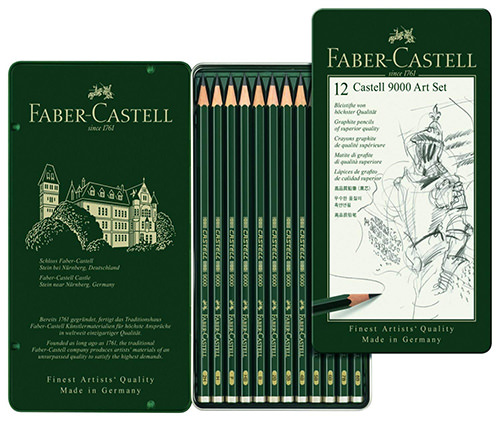
Faber-Castell’s 9000 range which was first launched in 1905, is my personal favourite and despite having tried many others I’ve so far never been swayed from it. I’m not necessarily saying that the 9000s are superior to the other pencils I’ve awarded top marks to, but for the type of drawing that I do (light, quite detailed portraits) they suit my style better than a darker, softer range. If it’s reliability and control you are after, then you really can’t beat them.
Faber-Castell are pencil specialists with an eminent and aristocratic history (they even have their own castle in Nuremburg!) going back to 1761. In the 1960s they patented their famous ‘SV’ bonding in which the entire length of the lead is glued to the wooden casing instead of simply spot-gluing it in places. It definitely works, as I’ve virtually never known a 9000 lead to break. 9000’s are dependable in other ways too: I always find the leads smooth and never gritty or scratchy and their grading scale is 100% consistent with the shades darkening smoothly and gradually as they rise up or down the scale. They are the lightest of all the pencil ranges I’m reviewing here and the harder grades make a very fine mark, but I don’t find them scratchy or the graphite overly shiny. They are very good for soft hatching, give off little graphite dust and erase well.

The 9000s are smart hexagonal pencil, in gold and cream on a dark green casing. My favourite fact about them is that their colour scheme was chosen by Count Alexander von Faber-Castell to match his military uniform! They are light to hold and have their grade printed clearly on every other facet so that they are easy to identify. You can buy a version of the HB and B grades with these soft little erasers on top.
It’s hard to find more than a few quibbles to complain about. The pencils run only up to an 8B grade and I find this a little frustrating considering how light the range is in general: it means that I have to supplement my range with a Staedtler pencil if I want to draw very dark shadows. I’d also prefer the hexagon facets on the casing to have very slightly softer edges because they are a little sharper than some of the other ranges.
MARS ‘LUMOGRAPH’ PENCILS
★★★★★ The best regarded mid-tone pencil with a huge range
RANGE 10H-12B, UK lowest price: £1.25 each (The Online Pen Company)
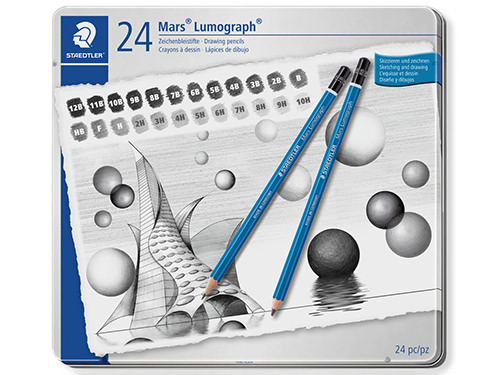
Despite being most functional looking all the pencils, the Mars Lumograph would probably still top the charts as the professional artists’ choice. Like Faber-Castell’s 9000 pencil they are another excellent example of German quality and it’s really hard to find anything to complain about with them! The Lumographs run a bit darker and softer making them the ideal mid-tone pencil, and the lighter grades feel smoother than the equivalent grades in the 9000s due to the slightly higher graphite ratio.
Lumograph pencils never scratch or feel gritty and as they rise up the scale the shades become darker in a most reliable and uniform manner. They have the widest range of grades of all of the pencils and go all the way up to a very black 12B, although grades above a 9B can be hard to source in the UK. The Hamilton Pen company carries all of the grades. With such a wide tonal range you are really covered whether you like to draw more lightly or more darkly. If you like to blend your pencils, you will find that they smudge fairly well.

Staedtler are an interesting company and are actually a non-profit corporation set up in 1835 to fund German universities. They have a long association with pencils, with members of the Staedtler family known to have been involved in the pencil trade back in the 17th century. The Mars Lumograph brand was registered in 1900 and so they’ve had a long time to perfect it: the pencils always seem perfectly bonded and I haven’t known even the darkest leads to break when sharpening. The grade is printed on every single facet of the pencil, which I find very helpful.
DERWENT ‘GRAPHIC’ PENCILS
★★★ A British classic which are very dark and good for blending but disappointingly scratchy and uneven
RANGE 9H-9B, UK lowest price: £1.24 each (Spectrum Art Shop)
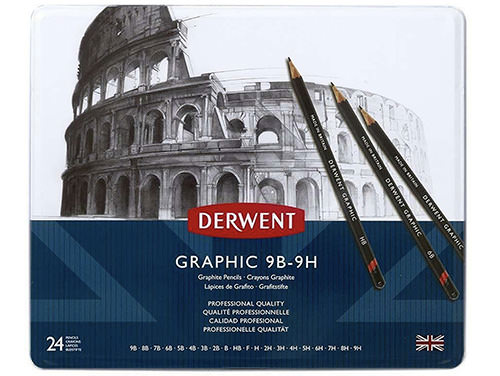
In the days before the internet when you had to visit an art shop in person, Derwent really dominated the market in the UK and choosing between artists’ pencils was usually just a case of ‘Derwent vs Faber-Castell’ or occasionally ‘Derwent vs Staedtler’. Derwent are an old British company (although now American owned) and are based in an area near the original Borrowdale mine in Cumbria where graphite was first discovered and was famously mistaken for lead.
Derwent have been making pencils since 1832 and ‘Graphic’ is their classic graphite sketching range. The pencils are very popular in the UK where many people rate them for their blending ability, but I personally feel that they don’t match the standard of some of their rivals despite the fact that they often cost more. The last batch I tried were distinctly scratchy and badly mixed, especially in the softer grades. The biggest frustration is that the grading seems inconsistent, with the 5B in my set drawing unmistakably darker in tone than the 6B!

The pencils don’t seem to be as well bonded as the Faber-Castells and Staedtlers and break more easily especially when you sharpen them, though this may be due in part to the soft crumbliness of the very dark leads. Because they are so soft the leads wear down quickly giving off a lot of graphite dust and they need sharpening a lot. This softness and the graphite dust that the pencils create do make them excellent for blending because they smudge so easily, and despite their dark tones they erase very well. They have a pleasing black casing that is slightly thicker than some of the other brands, and nice retro lettering.
KOH-I-NOOR HARDTMUTH: TOISON D’OR PENCILS
★★★★½ An excellent brand with extremes of tone, and amazing value for a professional pencil
RANGE 10H-8B, UK lowest price: £0.49 each (The Online Pen Company)
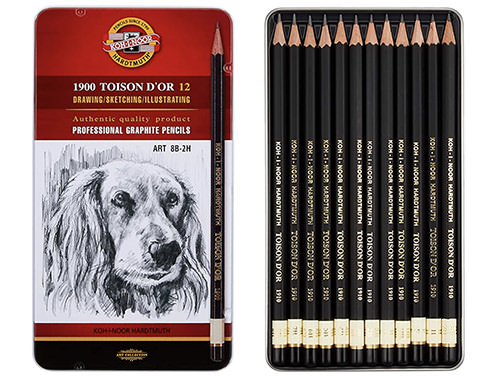
This pencil range hasn’t been available in the UK for that long and many people aren’t familiar with the Koh-i-Noor Hardtmuth company. When I first saw them I thought they must be a new, exotic import from California! It turns out I couldn’t have been more wrong: the Koh-i-Noor Hardtmuth company was founded back in 1790 and its Austrian founder Joseph Hardtmuth played an important role in the development of the modern pencil made from graphite and clay. The company also claims credit for the formation of the HB grading scale. It is partly named after the famous Indian diamond called the Koh-i-Noor which was one of the largest ever found and is now owned by the British monarchy and kept in the Tower of London.
Although you’re more likely to come across Koh-i-Noor pencils in a tin, you can also buy their professional grade Toison D’Or pencils separately. In either case they are surprisingly cheap which I find quite baffling because they are such an excellent pencil. They run pretty light in the harder grades and here are similar to Faber’s 9000 range, to which they would make an excellent alternative at less than half the price and without much compromise on quality.
The grades become darker very rapidly as they rise up through the grading scale, and they end up even darker than the Staedtlers in the softer B grades. Therefore you get quite an extreme degree of tonal gradation between the lightest and darkest pencils. My only complaint was a slight lack of consistency rising up through the grades. Whilst the lighter grades had felt very hard (maybe a bit too hard) there seemed to be a rather abrupt jump between the 2B and 3B grades where the consistency changed noticeably and the pencils suddenly became much smoother.

The Toison d’Or pencils all held their points well when sharpening and didn’t break easily. They are very attractive looking (I’m a sucker for packaging!) and are finished in a nice black matt lacquer with gold and cream. The grade is printed on every facet which makes it easy to locate the shade that you want and the hexagonal casing has nicely softened edges making it very comfortable to hold.
TOMBOW ‘MONO 100’ PENCILS
★★★★★ The very best dark toned professional pencil, that glides across the page
RANGE 9H-6B, UK lowest price: £1.85 each (Pencils4Artists)
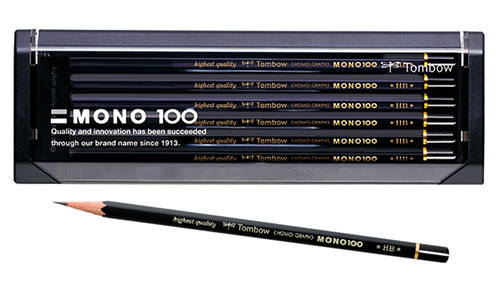
Tombow’s legendary Mono 100 pencil range was launched in Japan in 1963. It is beloved by many designers, draughtsmen and animators but is equally acclaimed for fine art sketching. Tombow pencils are generally hard to find here in the UK but a company called Pencils4Artists sells the Mono range at a reasonable price, and Jacksons also carry them at £2.10 each.
Mono 100s generally vie with the Mistubishi Hi-Uni for the number one spot amongst true pencil aficionados. Japanese wood-casing pencils tend to run very dark and soft and the Monos are indeed extremely dark – they only go up to a 6B grade, but the Mono 6B is even blacker than a 9B from the Staedtler or Derwent ranges. I like the smart look with their gold lettering over black lacquer, with a white stripe on the tip. They come unsharpened and it’s a bit of a killer on the wrist to sharpen a whole tin’s worth, unless you have an electric sharpener.

The Mono 100s really do live up to their reputation. Their smoothness is unsurpassed and they are well bonded, rise consistently (if very swiftly) through the grades and hold a good point even in a 5 or 6B. I was surprised at how strong and durable the darker grades were considering their softness: they don’t crumble and they don’t smudge too easily. Despite the fact that they are expensive to buy in the UK I think the Monos are still pretty good value because they’d last a long time before you sharpened them away.
Although the Mono range is much darker than the Faber and Staedtler pencils I generally use, I just loved the way that they glide across the page. The lighter grades are delightfully smooth too and if you wanted to draw more lightly with them you could use a selection of the H grades – I found that a 3H was tonally equivalent to about an HB from Staedtler’s Mars Lumograph range.
CARAN D’ACHE ‘GRAFWOOD’ PENCILS
★★★½ Highly regarded by some but not my favourite, apart from their innovative casing colours
RANGE 4H-9B, UK lowest price: £2.55 each (Pencils4Artists)
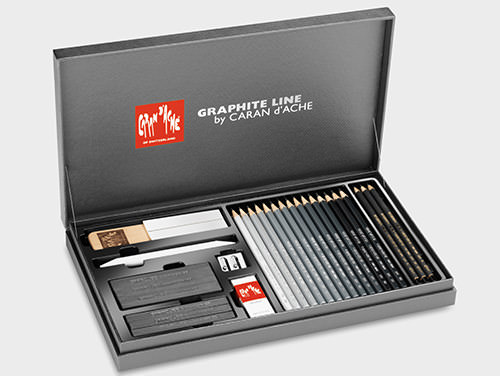
Caran D’Ache are a Swiss company, founded in 1915. There is a slight degree of confusion over their graphite pencil range, which goes by the name ‘Grafwood’ where the pencils are sold singly but come in a box called ‘Graphite Line’ when sold as a set. These pencils are really expensive at over £2.50 each and to be honest, I struggled to see why they merited such a high price. They certainly are a good pencil but I didn’t find them superior to all of the other ranges.
Grafwoods have one brilliant innovation which is that the casings are colour coded, so you can identify the grade of the pencil visually without reading the written grade indicator. The colours start from a pure white casing for the 4H grade, and then get progressively more grey towards the silvery HB. They then continue to darken through the B grades until they reach the carbon-coloured 9B casing.
The Grafwoods aren’t the most elegant pencils individually, but the ability to identify the grade I wanted so quickly was a revelation and I wish all ranges could have some kind of colour coding. However pencil companies are unwilling to drastically change their long established casing designs and so far the only ones to imitate the idea are Winsor & Newton’s student grade Studio Collection range which has a colour coded tip for the different grades.

I found the Grafwoods a very unusual pencil and I think they will polarize people in quite a number of ways. They are extremely large in diameter and feel very chunky in the hand, which some people will like and others will not. The texture is on the coarse side and yet there was a strangely ‘waxy’ feel to them, which again, I think some people might quite like but others won’t. I’m not sure why they have this unusual texture but pencils leads are finished in a wax bath to fill in any microscopic holes in the graphite, so I would imagine that the Grafwoods are given a particularly long soak.
Another observation I made was that despite the softer ‘B’ grades being blacker than almost any of the pencils I’ve reviewed here, their leads were super strong, gave off no graphite dust at all and would hardly smudge even when I tried. This will be a plus for some, but if you want a good blending pencil then the Grafwood really wouldn’t be for you. The biggest problem I had with them was an inconsistency in texture as they rise up the grading scale. The lightest grades felt really waxy and quite hard and drew very lightly indeed. However from 3B upwards the pencils drew so darkly that it was as if they came from a different range altogether. All in all I didn’t feel that the Grafwoods were for me, but I’d advise you to try them for yourself and make your own mind up.
CONTÉ À PARIS GRAPHITE PENCILS
★★★★ A limited and extremely dark range, but beautifully silky and very consistent
RANGE 3H-6B, UK lowest price: £1.60 each (Pencils4Artists)
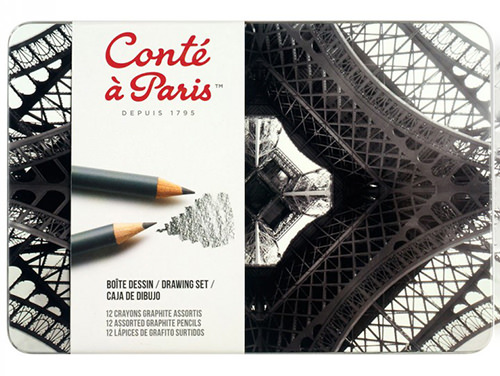
Conté à Paris is another illustrious pencil company and its founder Nicolas-Jacques Conté made a huge historical contribution to the development of the modern pencil when he patented his graphite and clay kiln-fired pencil in 1795. Although Conté are well known and popular in the UK their graphite drawing pencil range is not widely sold which surprises me because it really is very good. The pencils are fairly expensive here if bought individually and are better value when purchased in a tin, where because because the range of grades (only 3H to 6B) is so small you receive several duplicates.
I was a little astonished when I opened the tin to see that the pencils have round casings, which is something that I’ve rarely seen except in children’s pencils. At first I thought this was quite mad – the point of regular hexagonal casing is after all to stop the pencils sliding around on your desk – but then I picked one up and it felt so lovely, slim and smooth to hold that I was quite won over! I decided I’d be happy to draw with round pencils as long as I had a tin to keep them from rolling around. The only problem is that the attractive retro design of the casing is very restrained and grade of the pencil is only printed on them once and in tiny lettering. Therefore if you don’t put your pencil back with the lettering facing up you can’t tell which grade is which.

The pencils are very dark: almost as dark as the Tombows and with an even more limited range of grades. They seemed consistently well mixed with excellent bonding and drew with a slightly coarse texture, but felt silky and a pleasure to apply. I wouldn’t suggest using them for very fine work but for loose and very dark sketching I would absolutely recommend them. If you wanted to draw more lightly with them you’d need to use the H grades, but because these stop at only 3H there would be a limit to how light you could go.
CATEGORIES
DRAWING PEOPLE
DRAWING ANIMALS
DRAWING MATERIALS
OIL PAINTING
WATERCOLOUR
PAINTING MATERIALS
FRAMING

